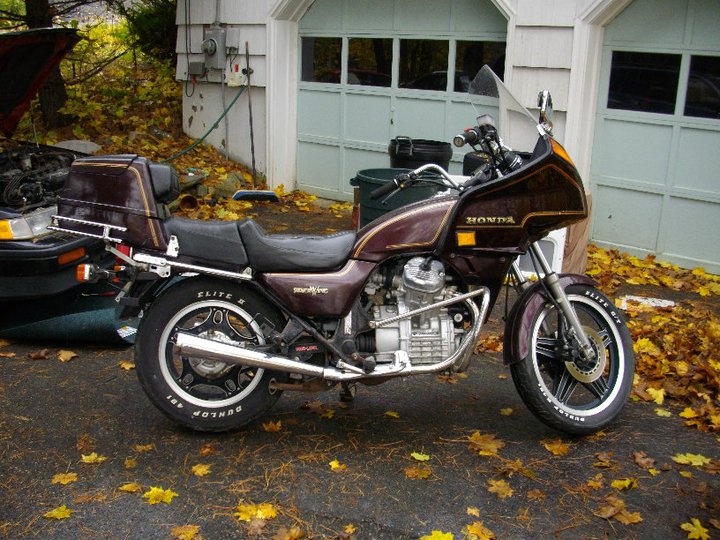
As a high school student without a car, I rode my bicycle everywhere instead. I was an active member of the Bicycle Mobile Hams of America, and contributed a number of articles to the early issues of their newsletter. I used to operate my Icom IC-2AT on the local repeaters while riding, using a variety of antennas over the years and a homemade headset that I "liberated" from a broken toy walkie-talkie. One time I helped with communications for a walk of some kind (I can't remember specifics - it was a while ago), and I essentially leapfrogged the walkers with my bicycle from checkpoint to checkpoint, keeping an eye on everyone in case of trouble. It worked well, and the bicycle was able to weave around the walkers far more safely than a car.
After high school, I got a car, and lost most of my interest in bicycling. Later on I got into motorcycles as well. This past winter, after picking up my latest toy - a 1982 Honda Silverwing GL500 Interstate - I got thinking to myself about the various bicycle rides and races that take place in Maine, and that a motorcycle mobile setup could do for them what my bicycle mobile setup did for the walks. Over the winter I collected the pieces, and in spring I began to put them together and put them to use.
The station
The rig is a Radio Shack HTX-202. I've wanted one of these since they first came out, and I got a deal on a package including a couple of batteries, a drop-in charger (the same one I used with my IC-2AT!), and a few other accessories. I chose this radio because it's built like a brick. OK, so it's also the size of one, far less convenient than my Yaesu VX-1R. But it was simple and rugged, likely to stand up to the rigors and especially the vibration of motorcycle use. Headsets are widely available - the primary reason why I didn't press one of my Kenwood TM-271A mobile rigs into motorcycle service. Best of all, I could power it directly from the bike, for a maximum of 5-6 watts output. It's not nearly as much as a mobile rig, but with a good antenna it should be enough to get into the local repeaters reliably.And the antenna is the real trick on two wheels, powered or otherwise. The typical mobile antennas will work, but not nearly as well as on a car, since a bike doesn't have much of a groundplane. So I chose a 1/2 wave vertical for 2 meters, which shouldn't require one. I also picked up a mount to clamp onto one of the chrome rails on the side of the trunk, ran the coax under the seat and gas tank, and replaced the UHF connector with a BNC for use with my HTX-202.
Power was very easy to provide. The bike came with an uninstalled pod for two speakers and a tape deck, with the power wires (constant and switched - there's actually an accessory position on the bike's ignition switch) coming out of the fairing. I don't intend to listen to music while I ride, so I cut the broken plug off an old 3-way cigarette lighter power splitter and attached it to the ground and switched power. Now, with the key in the accessory or on positions, power is supplied to not one but three lighter outlets. I can plug in not only the HT but also my GPS and whatever else I want to bring along.
The real trick was the headset. I picked up this one from Kawamall. It featured two speakers and a boom mic that attach to my full face helmet, plus a PTT switch that mounts to the handlebars. Hook it all up, and I should be set to go.
The tests
Everything physically mounted exactly the way I wanted it to. The HT sits in one of the small storage bins on the fairing, with all the cables leading in and out of it. Power simply comes from the standard cigarette lighter power cord. The antenna works beautifully. From my driveway I was able to hit mountaintop repeaters up to 50 miles away with 5 watts. And the audio from the headset came through very clearly. It was time to put it all together and go for a ride.That's where I ran into trouble. With the bike in motion, I found myself unable to bring up even the local repeater a few miles away, even with 5 watts. At rest, it wasn't a problem, but once I started rolling I couldn't get in at all. It rather defeats the purpose of going motorcycle mobile!
To date, I haven't worked out the problem yet. I suspect it may be something to do with the input audio from the headset. My Kenwood speaker mike that I use with this HT is rather "hot" - I have to hold it about 2 feet away from my mouth to not overdrive my audio. In a car, it picks up too much background noise to be usable. But it doesn't drop out of the repeater, either. Perhaps this issue, plus the particularly noisy environment of a motorcycle (despite running a stock exhaust), may just be too much for it to handle. It's been suggested to me that the extremely high audio level may be causing the radio to overdeviate, and the repeater will not key up because of that. The HT's built-in microphone works just fine, with perfect audio level and quality.